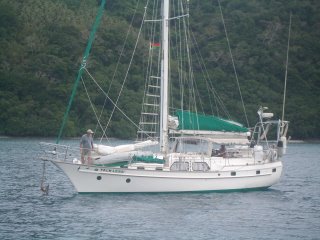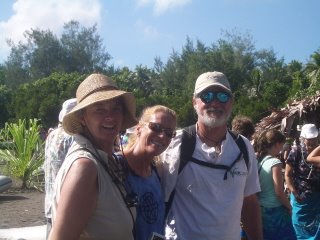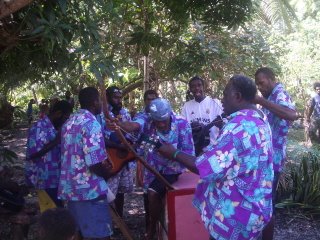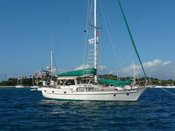Tackless II's Home Page & Website
Women & Cruising Website
Jimmy Cornell's Noonsite
Seven Seas Cruising Association
Fiji's Weather Site Victoria University's S. Pacific Weather Site Fijian History Palmlea Lodge and Bures Nukubati Resort Musket Cove Vuda Point Marina First Landing Resort About Vanuatu About New Caledonia
8 August 2008 -- The 2Cs in Tanna
6 August 2008 - Arrival in Port Resolution
080805 - Antidote to the 2C Blues
080804 -- At sea!
080803 - T2 goes to Sea
August 1, 2008 - Pictures
23 July 2008 – Color Us GONE!
14 July 2008 – She Floats!
FOURTH OF JULY, 2008 -- Musket Cove Style
If there was ever a place to see the effect that physical geography can have on the development of culture, Vanuatu is the place. Because of steep terrain, villages here have evolved independently of one another, developing different languages and different customs. Even today, with airstrips and cell towers and public education, geography still has its influence. Southwest Bay on the island of Malakula has an airstrip at the village of Wintua, but no roads and no vehicles. It just happens to lie on the "wrong" side of Malakula, off the beaten path of cruising sailboats trying to fit as many "name" anchorages in as possible so few cruisers find their way in. And yet it is about as idyllic an anchorage as any cruiser could hope for – spacious yet well protected from the majority of winds (N-E-S-SW!), no swell, great holding, some decent snorkeling and diving and several friendly villages. There's even a modern Kiwi farm offering fresh eggs for sale, as well as occasionally local meat, fresh fish, chickens (!!live!!) plus the have a burn bit for trash!
It seems that several weeks ago, Luc and Jackie of the yacht Sloepmouche (cruisers who have paused here in Vanuatu the past two years) sailed into Southwest Bay. Over chats with local chiefs it transpired that the villagers would do just about anything to increase visitor traffic to the bay. Indeed last year one of the villages undertook to put on a program for a small cruise ship that made several visits. The villagers went away for some training and put together a relatively polished presentation. Then the cruise ship didn't come anymore. So Luc, who is an active contributor to the SSCA Bulletins, undertook to coordinate a cruiser festival here in conjunction with the chiefs. The three villages planned a three-day event, and Luc got the word out over the coconut telegraph, with the result that some thirty-four boats assembled for the event! 
I'm sure others may have been put off by the idea of such a crowd, but in fact, the anchorage could easily hold three times as many boats. We are all swinging free with plenty of room between neighbors. And while the critical mass of cruising boats and their crews has been a revelation for the locals, it's also been quite a social occasion for the yachties themelves, many of whom haven't crossed paths in years.
The three villages involved in the event are Lembinwen, Lapo, and Tenstick. The festival began at Lembinwen, a large village on the bank where a salt water river flowing briskly from a huge tidal lagoon meets the bay. Central to the day was the dedication and opening of the Southwest Bay Yacht Club. The "yacht club" phenomenon is found all though Vanuatu. In traditional places where areas, buildings and pathways hold all sorts of traditional restrictions and taboos (particularly with respect to outsiders and women), having a building where yachties can gather to mingle with the locals without inadvertently treading on those traditions has been a successful compromise. Lembinwen was keen to have one and built the thatch hut in a matter of weeks.
But it could not happen without a lot of pomp and ceremony.  The yachties were greeted on the beach with drinking coconuts and hibiscus flowers for each lady. There was a receiving line and a string band
The yachties were greeted on the beach with drinking coconuts and hibiscus flowers for each lady. There was a receiving line and a string band  (evidently every village has their own) and an emcee with a megaphone. We learned later that the megaphone is a regular part of village life, a way for the chief to "send out" messages to the village, a tropical town crier, if you will. In the hands of Charlie, Lembinwen's emcee for the day, it was a non-stop white noise as he shifted back and forth between languages and panned his voice this way or that to target various groups of yachties or villagers in a relatively vain effort to herd us all along …vain of course because he was completely incomprehensible! There was a flag-raising on the beach, a banner held up by adorable children we needed to walk under, and speeches from a thatch dais by several chiefs, who were terrified at addressing a crowd of white foreigners in English if the trembling paper holding the composed speech was any indication! There was even a white ribbon on the door of the new yacht club that had to be cut with scissors at yet another flag raising.
(evidently every village has their own) and an emcee with a megaphone. We learned later that the megaphone is a regular part of village life, a way for the chief to "send out" messages to the village, a tropical town crier, if you will. In the hands of Charlie, Lembinwen's emcee for the day, it was a non-stop white noise as he shifted back and forth between languages and panned his voice this way or that to target various groups of yachties or villagers in a relatively vain effort to herd us all along …vain of course because he was completely incomprehensible! There was a flag-raising on the beach, a banner held up by adorable children we needed to walk under, and speeches from a thatch dais by several chiefs, who were terrified at addressing a crowd of white foreigners in English if the trembling paper holding the composed speech was any indication! There was even a white ribbon on the door of the new yacht club that had to be cut with scissors at yet another flag raising.
Considering that this was Lembinwen's first such event, they did a very fine job. They had a whole series of demonstrations of village life planned; climbing coconut trees for nuts, cutting said nuts open for drink or meat, cooking a pudding of coconut and plantain in tubes of bamboo of a fire, starting that fire without matches, and of course weaving useful carryalls out of pond fronds. They also gave a cursory demonstration of how their outrigger canoes are constructed, and a shy fellow showed the traditional sand-drawing, where images are created without ever lifting the finger. We had a nice lunch of beef stirfry, taro, and a fancy bread and banana concoction, which surely used every plate in the village's possession, and then we all climbed up a hill (where hand-rails had been lashed helpfully to the path-side trees) to watch a ladies' grade-taking dance.
Unfortunately, what explanation of the dance Charlie and the megaphone provided was not clear enough that many of us appreciated what we were seeing. It is only after coming back to the boat and reviewing my Lonely Planet did I start to get a clue. Grade-taking, usually associated with men only, is a process whereby individuals increase status within the community. According to the Lonely Planet, the men "earn respect by publicly disposing of their wealth in a series of elaborate ceremonies"…"accompanied by the ritual killing of pigs." What they are after from the pigs are the boar's tusks, which take six to seven years to grow, so one has to own a lot of pigs that reach maturity to collect the required number of tusks to reach "high levels of society." It seems that the southern Malekula women are the only Vanuatu women to take grades.
What was perhaps slightly uncomfortable was that the ladies danced topless. It is an odd jump to make from women in Mother Hubbards (the smock-like dress introduced by missionaries) to the same women in grass skirts and vines. These are not the nubile virgins most of the men were hoping to see, but matronly figures, to put it kindly, and the dance was a fairly monotonous chant and tread around a "house" made of saplings, which the ladies eventually entered and then pushed down for the finale, a symbolism lost on us.
After the dance, about half the cruisers opted for the lagoon tour – a fast trip in a line of dinghies through the huge estuary up the river.
The next day was pretty much a rerun, except that presented by the villagers of Lapo, the ones who had trained for the cruise ship, every phase was more coordinated and more polished. Instead of flowers for our ears we had leis (which work better for white people!),
there were straws for our drinking coconuts, the benches at the beautifully landscaped dance ground had backs to them (!!!!), the lunch was somewhat more elaborate, and the guy on the megaphone was much easier to understand. As we landed our dinghies on their beautiful beach, we were parceled into groups of ten and given a guide for the day. The guides were more effective than Charlie's amplified directions had been, but even so I am quite sure the guides found cruisers much more challenging to "herd" than the cruise ship passengers had been!
The two big differences in the day were the village tour and the dancing. Lapo (pronounced LaBO) is the Swiss village of southwest Bay. The thatch huts climb the steep hillside along a path that switches back and forth up through dense jungly forest. The houses, though still stick and thatch, seemed larger and more westernized in style, with porches and windows, some with screens and others even with glass, motivated, I presume, by the gorgeous vistas and the cool breezes. One little cluster had three tombs in the front, (rather Samoan style), there was a nice little Presbyterian church, and deliberate effort at landscaping with flowers and shrubs along the paths was evident everywhere. Near the top of the villages was a waterfall with a Jacuzzi like pool for kava drinking.
As for the dancing, this time it was men's dances and the men were in Kastom-dress.
Unlike the "participatory' dances we saw in Tanna (and here I consult Lonely Planet again), the two dances we saw in Lapo were "impersonation" dances where the men "pretend to be an ancestor or legendary figure" which allows the use of elaborate masks or headdresses.
Below they wear little more than penis sheaths and decorations of leaves, including colorful tufts from their backsides like rooster tails. Unlike the women, the men were easier on the eye, revealing fitter more muscular flesh. (We were told that one reason the men don't run to fat like the ladies is that kava – in these villages restricted to men's consumption – is an appetite suppressant!). Also the men's dance was accompanied by the drumming of a set of three elaborate tamtam (carved wooden slit-drums), which was very stirring.
The costumes and headdresses were truly memorable (different in each dance), but the dance steps themselves were the same for both dances, a handful of slow deliberate steps, then a flurry of fast double-timers when the drum beat sped up.
The art, of course, is doing it while keeping the headdresses upright.
Of course, just as we were all sitting there thinking the dance steps were rather unexciting, we were invited to come out and join the dancers. It wasn't so easy…and that's without headdresses!
All in all another nice day.
The third day of the festival was a more relaxed opportunity to visit the small hamlet of Tenstick, located on the westernmost point of the bay and named for the haystack islet just offshore. It seems in WWII the pilots based at Espirito Santo paid the villagers "ten sticks" – or ten cigarettes – to use the islet for target practice. Here the main attraction was to be snorkeling and diving, but the good weather that had blessed the first two days of the festival failed, and the morning was beset with a chilly drizzle. As you might guess, most of the cruisers, overdosed on village visits from the previous two days, opted to stay home. On Tackless II this captain was feeling a bit under the weather as we had celebrated Don's big SIX-OH the night before (more on that later). But when someone announced on the radio that perhaps these villagers had gone to more preparation than we'd been led to expect, we, like several others, clambered into our dinghies to pay our respects.
The Tenstickers had their own string band, their own hibiscus flowers and drinking coconuts to offer (these with straws of "cabbage stems"!), a table of snacks to try, and some crafts and shells to sell. Both men and women were on the beach to greet us, and sat around to chat. Don and David (the Runaway Bay crew had caught up with us in time for the BiG SIX-OH dinner) had a tour with the chief, and David invited the chief to visit our boats in the morning (Damn, gotta cleanup AGAIN!) Afterwards we took our snorkel gear to check out the reefs around Tenstick Islet, and were sufficiently impressed with the clear water and reef landscape to plan a scuba dive tomorrow.
If you are wondering what the villagers got for their efforts, it is common to ask a fee. After all, these traditions, reefs and National Geographic opportunities are all these people have to market. On the first day, Lembinwen asked only for gifts of our discretion (and they collected quit a heap!); at Lapo they asked the equivalent of $30 a head (a bit dear), and at Tenstick $3 bought us access to the reef.
Don's BIG six-OH!August 13th came around again this year, and it was mighty nice of the folks of Southwest Bay to throw this big party for Don, cause i'd been wondering waht special thing I could to celebrate. It was our friends Randy and Sherri of Procyon that alerted us to it as a perfect place to meet up for the occasion, and very fine that our "newest best friends" David and Chrissie of Runaway Bay put the push on to get here in time. Other than the events of the festival, Don's big day started with sat phone calls home as well as well-wishing by email, and ended with a big dinner for six in Tacky Two's cockpit. Randy and Sherri contributed a sinful chocolate cake and a split of champagne, Dave and Chrissie a lovely fruit compote and yam fritters, while I strove to provide cheeseburgers in paradise…which, believe me, in Paradise is no easy feat. My homemade buns, such a success in Tonga two years ago, were a bit of a flop, and the burgers, down-sized twice before grilling to fit the buns ended up more like White Castles' infamous sliders. Damn, I shoulda thought to grill onions!!!! My potato salad, however, was more successful, thanks to Chrissie's bringing us provisions from Port Vila.
Although we miss being close enough to home that the family could make a big fuss over us for milestones like these, the cruising way has its virtues: celebration by like-minded souls in like situations with similar thoughts of where we are in life and what we want from what remains us.
15-18 August 2008 – ‘Tween Time
Southwest Bay was the kind of place one could hang on the hook indefinitely, especially with the ability to restock beef, fish, eggs as well as lemons and limes from the Kiwi Farm. On the Friday after the hoopla of the festival died down and as the fleet started to disperse, we did manage to fit a scuba dive in on the reef on the west side of the pass between Tenstick’s islet and village. Don and David actually opted to sit on the surface and schmooze about boat systems while Chrissie, a newly certified diver, and I went for a very nice dive through a system of caverns and pinnacles, my favorite kind of landscape. Hard to believe Chrissie was a newbie!
In the afternoon, Don and I went ashore to collect a sarong I had purchased from a woman named Marklynn at the Tenstick do the day before. We found her house as she’d described, the last compound on Lembinwen village’s west end. She and her husband Silon made us welcome in the family’s main building, a structure of cement and stone up two feet, topped by the traditional vertical stick walls, and an absolutely beautiful thatch roof. The building housed an open space probably 25’x40’, and inside was almost nothing! Against one wall in the corner was a bench with some cooking pans, and the sarong I was picking up was pinned to the wall above it. Their son Anthony, a handsome young man as yet unmarried, is one of the musicians in the village string band, so of course we had to buy a copy of their just-released CD (produced very professionally by a Peace Corp worker.) Later when Marklynn went to get a gift for me (my very own, very pink Mother Hubbard dress…so I “could have a proper dress!), she went into a smaller hut nearby, so we deduce each member of the family as their own sleeping hut.
Aside from the new and spacious compound, Silon and Marklyn are distinguished by keeping pets. In a stone and cement pool built into the sand, Silon keeps five turtles – four hawksbill and one green turtle – that he says he has raised from babies. Keeping turtles for four years takes a lot of work. They feed the turtles rice and change the water every day, and Silon claims they take the turtles out in the sea for swims. He says he keeps them to teach the community children that turtles are protected now and not to be caught or shot for food. He also has a flying fox in a cage, which he acquired when one of the boys shot the mother with a slingshot and the baby was found tucked under her wing. All the animals seemed happy and clean and friendly with the family.
On our way out, Silon led us on a tour through Lembinwen village. Even though we had spent a day there for the festival, we actually had not seen much of it. Wandering around unattended is not encouraged. It turned out to be quite densely built up (no wonder Silon moved to the suburbs!). We saw two of the three churches (Presbyterian, SDA and CDC…I know what SDA is, but not CDC!), an actual open air stage for the band and other village events, a volleyball court, the primary school, the chief in his undershorts and well, you know….village life.
The next morning we took advantage of the light winds and motored back around the south end of Malekula to the Maskelyne islands at Malekula’s SE corner. This was a change of plan. Originally, I’d thought we’d sail with Runaway Bay north up to Luganville on Espirito Santo, where the US military base was during WWII and where there are several spectacular wreck dives (the USS President Coolidge, a 654-foot former luxury liner that was serving as a troop ship when she struck a friendly mine and sank, and the infamous Million Dollar Point, where the US navy dumped thousands of tons of equipment after the war.) However the Coolidge is a deep dive which I am avoiding these days, and Don was lukewarm about diving on his own, and with the weather report predicting strong easterlies coming in within the week, we were concerned about getting pinned in up there when we would need to get back southeast to Efate. So, instead we decided to proceed with Procyon and other friends over to Ambrym Island for a famous Rom dance festival
The Maskelyne Islands are a pretty little group of seven islets and extensive reef areas. We tucked in to a super protected anchorage behind the coral-fringed islet of Awea (S16*31’.9; E169*41.’2) with a bunch of friends, and quite honestly, never put the dinghy down. With two festivals behind us and another to go, we were perfectly happy just to sit on our boat and do as little as possible. Of course, that didn’t stop people from visiting us. Marjetka, the Slovenian single-hander, and her wonder dog Cherie were there and came and spent an afternoon visiting, as did Randy and Sherri of Procyon. Also we had a few visitors that came by canoe, most memorably Martin and his five-year-old son Thatcher! We enjoyed chatting with Martin, and although he had nothing to trade, we ended up making him a gift of some reading glasses which he sorely desired.On Monday morning, the wind picked up to a respectable 15 knots and the entire anchorage emptied out in a steady stream and set sail for the NW tip of Ambrym Island about 46 miles away. As the fleet sailed out, we had to give way to the local canoes, now alll equipped with sails!
Since Ambrym is Vanuatu’s other big active volcano, we were concerned about picking up ash and fumes as we sailed by its leeward side, but fortunately for us the main impact was some locally-generated wind patterns switching the southeasterlies abruptly to northwesterlies! Still we had another great sail and settled into the relatively open roadstead off Nebul village known as Rodd’s anchorage (S16*06’.5; E168*.07’.7).
Labels: Diving, Hiking, Rally Experiences, Traditional Festivals, Vanuatu
or Posts by Topic links in the upper left!
For our Australia posts starting in late 2008 see
Australia Blog
The Blog Template is generated via PsycHo and is Licensed.

Bill
s/vGeodesic2
When we statesiders / landlubbers - don't see at least a weekly post we get nervous about your safety!!!
Sooooo, post us up please
Uncle Bill
s/v Geodesic2